
IEEE Access
.pdf
N. Q. Do et al.: Deep Learning for Phishing Detection: Taxonomy, Current Challenges and Future Directions
FIGURE 13. Accuracy and loss of various DL models.
number of epochs, batch size, type of optimizer, learning rate, type of activation function, etc. The same set of parameters was used in this research across all DL models just for the purpose of empirical analysis to highlight the current issues of DL in phishing detection. Fine-tuning will be added in future research to nd the optimal set of parameters for each DL model that can produce the highest detection accuracy.
VOLUME 10, 2022
The loss and accuracy of various DL models during training and validation are illustrated in FIGURE 13. The accuracy for each DL model is shown in the upper graph, while the loss function is displayed in the lower plot. As the number of epochs grows, the accuracy starts to increase, while the loss function begins to decrease. The training accuracy, or training loss, is represented by a blue line, whereas the validation result is displayed in orange. A large gap between training and
36449

N. Q. Do et al.: Deep Learning for Phishing Detection: Taxonomy, Current Challenges and Future Directions
TABLE 11. Selected studies for this slr.
36450 |
VOLUME 10, 2022 |

N. Q. Do et al.: Deep Learning for Phishing Detection: Taxonomy, Current Challenges and Future Directions
TABLE 11. (Continued.) Selected studies for this slr.
VOLUME 10, 2022 |
36451 |
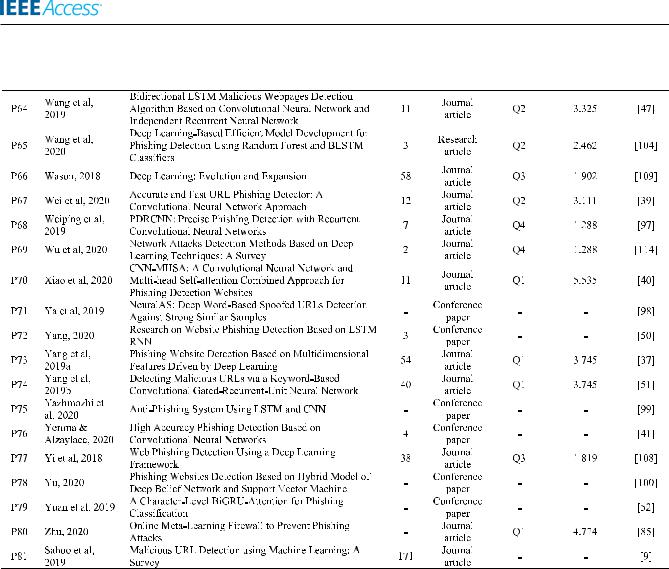
N. Q. Do et al.: Deep Learning for Phishing Detection: Taxonomy, Current Challenges and Future Directions
TABLE 11. (Continued.) Selected studies for this slr.
validation results is also known as over tting problem [96]. Over tting usually occurs when the model performs well on the training set, but poorly on the validation set, causing the training accuracy to be much higher than the validation accuracy. As a result, the smaller the gap between the blue and orange lines, the better the phishing detection model. In other words, the faster the training and validation graphs converge, the more ef cient the DL algorithm. Most of the time, issues caused by over tting can be prevented by using regularization techniques, such as batch normalization, early stopping or dropout [22], [23], [94], [101]. As can be seen from the graphs, CNN, LSTM and GRU models are less prone to over tting problem since they implemented dropout function. In contrast, DNN and MLP algorithm might suffer from over tting because none of the regularization techniques were used in the implementation of these DL models.
The results obtained from the experiments are summarized in TABLE 10. A set of metrics used to evaluate the performance of DL algorithms consists of FPR, FNR, Precision, Recall, F1-Score, AUC, and Accuracy. An effective and ef cient phishing detection model is expected to have high Precision, Recall, F1-score, AUC, and Accuracy, while
36452
low in FPR and FNR measures. From these gures, it is observed that the accuracy of the ensemble DL model is higher than the individual model. For instance, among the LSTM models, ensemble LSTM architectures have slightly higher accuracy than a single LSTM model. The accuracy rate of LSTM-LSTM and BiLSTM-BiLSTM models are 93.76% and 92.67%, respectively, whereas that of the single LSTM architecture is 92.49%. Similarly, GRU-GRU has the highest accuracy level (95.75%) among the three GRU models, while a single GRU has the lowest accuracy measure (93.49%).
These results are consistent with what has been discussed in the previous section, in which ensemble DL models combine the strengths and resolve the weaknesses of individual models to achieve higher performance accuracy. It is also observed from the experiment that LSTM and GRU take longer training time as compared to any other models. In addition, among the LSTM architectures, the duration to train ensemble LSTM models is longer than the training time of a single LSTM model. These results are also in accordance with the previous literature in which the more complex the DL architecture is, the longer the training time. Therefore,
VOLUME 10, 2022
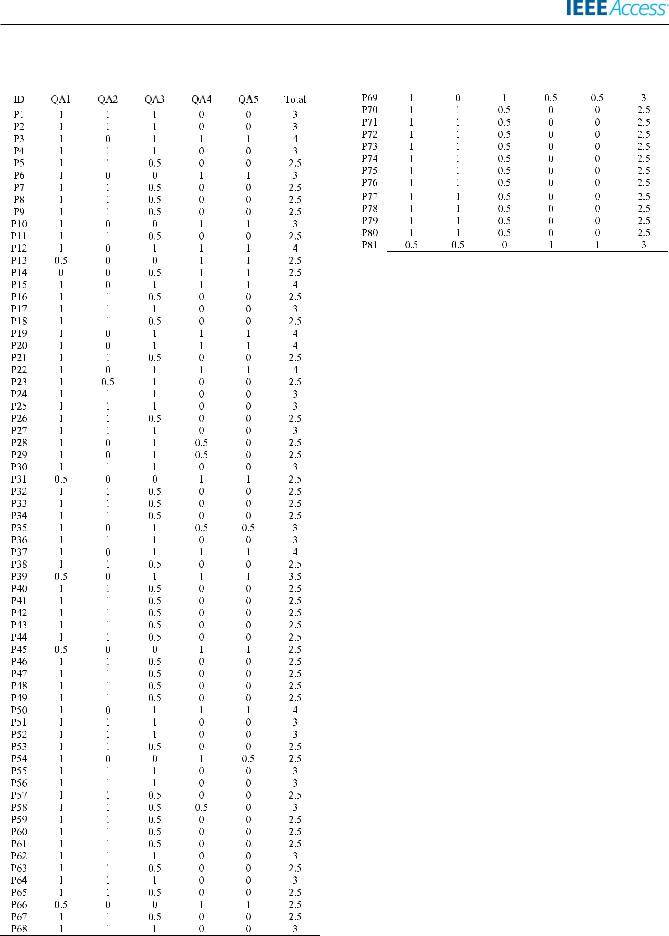
N. Q. Do et al.: Deep Learning for Phishing Detection: Taxonomy, Current Challenges and Future Directions
TABLE 12. Quality assessment score of the selected studies. |
TABLE 12. (Continued.) Quality assessment score of the selected studies. |
|
|
|
|
|
|
|
VOLUME 10, 2022
besides having an effective DL model that can produce high detection accuracy, it is also crucial to reduce the training duration, since longer training time requires higher computational resources.
In short, the empirical results obtained from the experiment of various DL models have manifested the following issues that need to be addressed. First, there is no speci c guideline for an optimal set of parameters that yield the best performance accuracy in detecting phishing attacks. Researchers need to nd-tune these parameters manually by conducting very tedious and time-consuming series of experiments. Second, individual DL models might produce lower accuracy as compared to ensemble or hybrid models. As a result, it is recommended to combine different DL algorithms in a phishing detection model to have an effective and robust solution to ght against phishing attacks. Last but not least, training duration is another factor that needs to be taken into consideration. Even though ensemble and hybrid DL models have higher accuracy, they might also take a longer time to train. This becomes a problem because a longer duration requires higher computational cost, which reduces the model's ef ciency.
This section has assessed the classi cation performance of different DL algorithms and discussed their related limitations by analyzing several DL models in a practical context. The empirical analysis was performed with recently published, publicly available and commonly-used dataset for benchmarking and evaluation in phishing detection. In addition, the performance of various DL models was also evaluated with a set of standard metrics frequently used for validation in the phishing detection domain. Altogether, the benchmarking dataset, the evaluation metrics, and the empirical results were discussed to highlight the overlooked issues along with the perspectives that encourage researchers to explore DL and navigate the future research directions of phishing detection in this regard.
VII. CONCLUSION AND FUTURE WORK
To sum up, DL has caught much attention among researchers across numerous application domains. DL can handle complex data and extract raw features automatically without prior
36453
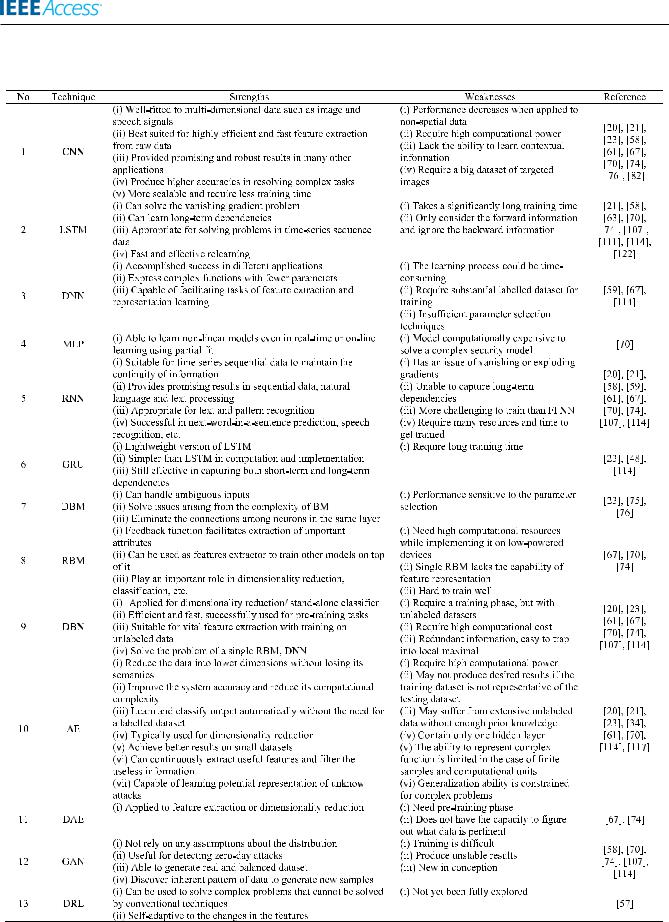
N. Q. Do et al.: Deep Learning for Phishing Detection: Taxonomy, Current Challenges and Future Directions
TABLE 13. Strengths and weaknesses of various DL techniques
36454 |
VOLUME 10, 2022 |

N. Q. Do et al.: Deep Learning for Phishing Detection: Taxonomy, Current Challenges and Future Directions
TABLE 14. Convolutional neural network (CNN) for phishing detection.
knowledge. DL has become one of the top interested topics in the cybersecurity with the advent of new technologies and the rapid growth of data in the big data era, especially
VOLUME 10, 2022
in the phishing detection eld. As a result, this study provided a comprehensive review of DL for phishing detection through an in-depth SLR approach. The paper also offered a
36455
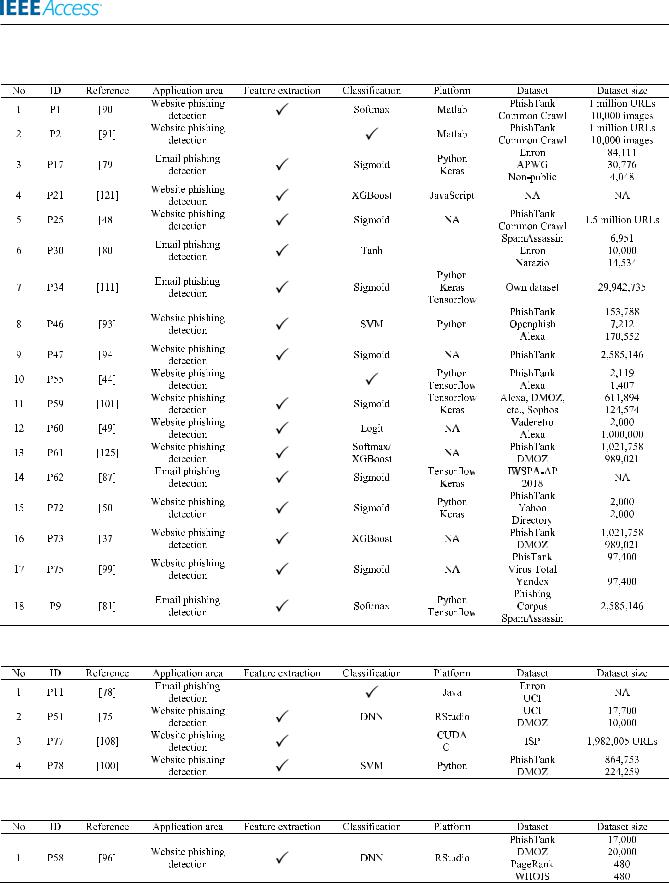
N. Q. Do et al.: Deep Learning for Phishing Detection: Taxonomy, Current Challenges and Future Directions
TABLE 15. Long short-term memory (LSTM) for phishing detection
TABLE 16. Deep belief network (DBN) for phishing detection.
TABLE 17. Deep boltzmann machine (DBM) for phishing detection.
signi cant insight into the current issues and challenges that DL faces in detecting phishing attacks by analyzing the trends and patterns of 81 selected articles from various sources. This
36456
research has drawn a taxonomy for phishing detection and DL to classify them into several classes based on a thorough analysis of the relevant studies. Phishing detection was
VOLUME 10, 2022

N. Q. Do et al.: Deep Learning for Phishing Detection: Taxonomy, Current Challenges and Future Directions
TABLE 18. Bidirectional long short-term memory (BILSTM) for phishing detection.
TABLE 19. Deep neural network (DNN) for phishing detection.
TABLE 20. Stacked autoencoder (SAE/DAE) for phishing detection.
classi ed according to different media and methods, while DL was classi ed by the application areas, techniques and datasets. Moreover, this paper also differentiated DL from traditional machine learning, and analyzed the strengths and
VOLUME 10, 2022
weaknesses of several DL algorithms used in the previous studies. Finally, an empirical analysis was conducted to highlight the open issues discussed in the literature and identify possible research gaps for future directions. The
36457
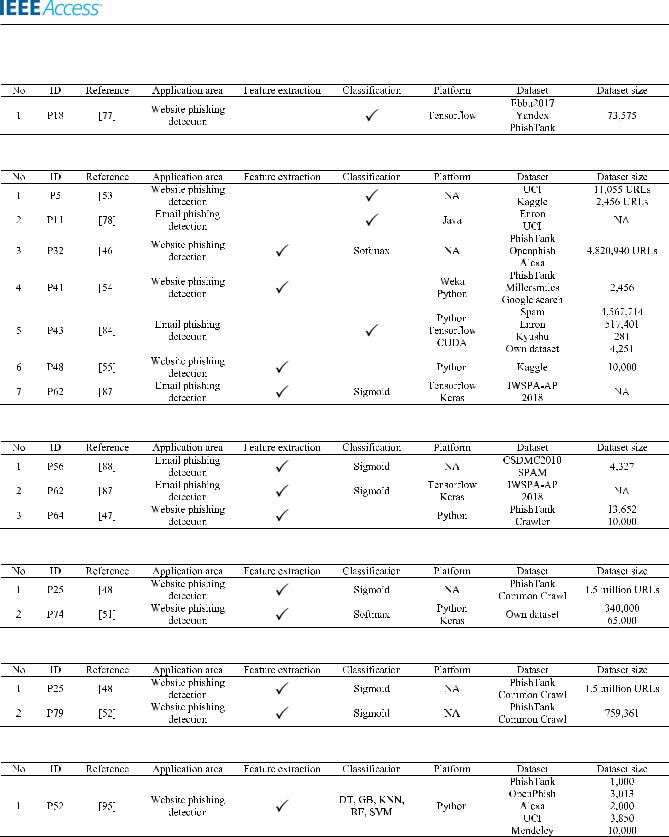
N. Q. Do et al.: Deep Learning for Phishing Detection: Taxonomy, Current Challenges and Future Directions
TABLE 21. Deep reinforcement learning (DRL) for phishing detection.
TABLE 22. Multilayer perceptron (MLP) for phishing detection.
TABLE 23. Recurrent neural network (RNN) for phishing detection.
TABLE 24. Gated recurrent unit (GRU) for phishing detection.
TABLE 25. Bidirectional gated recurrent unit (BIGRU) for phishing detection.
TABLE 26. Adversarial autoencoder (AAE) for phishing detection.
results obtained from the empirical experiments indicated that the most common issues among DL techniques are manual parameter tunning, long training time and de cient performance accuracy. These ndings imply that further efforts need to be taken to improve the state-of-the-art DL algorithms
36458
in terms of ne-tunning, training duration and detection accuracy, to ensure a robust and effective system for detecting phishing attacks in cyberspace. These outcomes also suggested that in addition to optimization techniques and ensemble methods, integrating DL with big data or cloud-based
VOLUME 10, 2022
